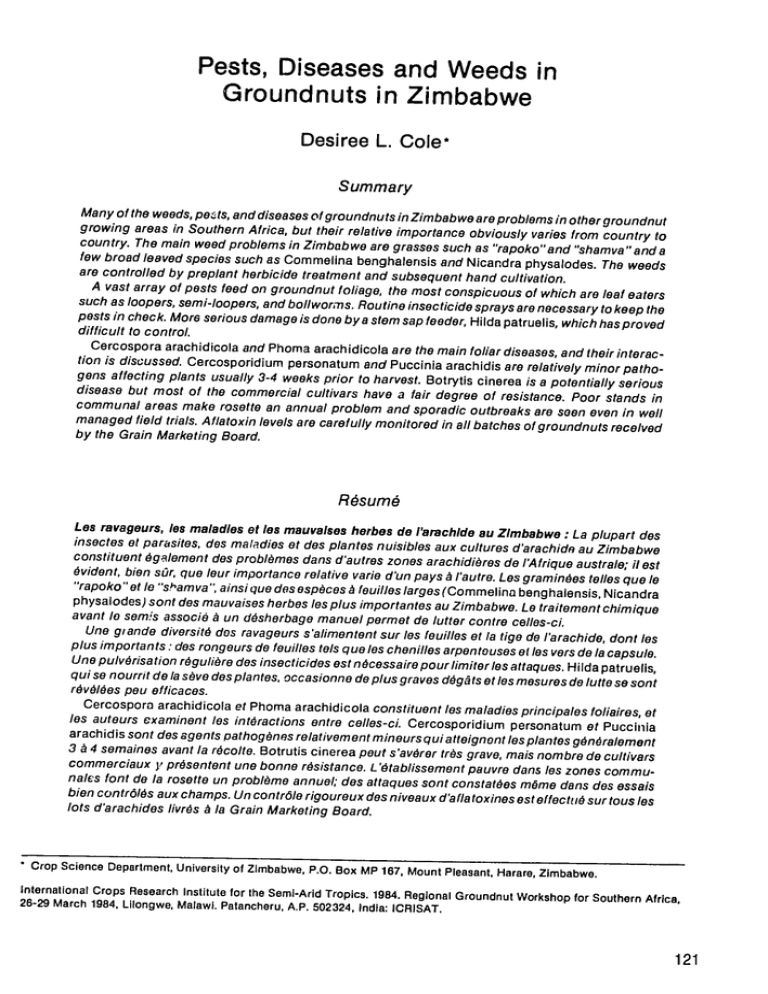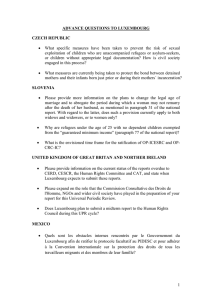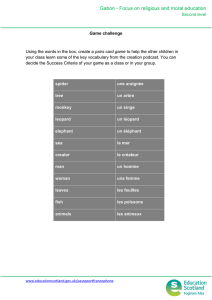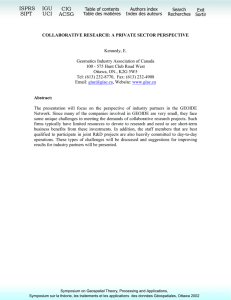Pests, Diseases and Weeds in Groundnuts in Zimbabwe
advertisement

Pests, Diseases and Weeds in Groundnuts in Zimbabwe Desiree L. Cole* Summary Many of the weeds, pets,and diseases ofgroundnuts in Zimbabwe are problems in othergroundnut growing areas in Southern Africa, but their relative importance obviously varies from country to country. The main weed problems in Zimbabwe are grasses such as "rapoko"and "shamva"anda few broad leaved species such as Commelina benghalensis and Nicandra physalodes. The weeds are controlled by preplant herbicide treatment and subsequent hand cultivation. A vast array of pests feed on groundnut foliage, the most conspicuous of which are leaf eaters such as loopers, semi-loopers, and bollworms. Routine insecticide sprays are necessary to keep the pests in check. More serious damage is done by a stem sap feeder, Hilda patruelis, which has proved difficult to control. Cercospora arachidicola and Phoma arachidicola are the main foliar diseases, and their interac­ tion is discussed. Cercosporidium personatum and Puccinia arachidis are relatively minor patho­ gens affecting plants usually 3-4 weeks prior to harvest. Botrytis cinerea is a potentially serious disease but most of the commercial cultivars have a fair degree of resistance. Poor stands in communal areas make rosette an annual problem and sporadic outbreaks are seen even in well managed field trials. Aflatoxin levels are carefully monitored in all batches of groundnuts received by the Grain Marketing Board. Rdsum6 Les ravageurs, les maladies et les mauvalses herbes do l'arachlde au Zimbabwe: La plupart des insectes at parasites, des maladies et des plantes nuisibles aux cultures d'arachide au Zimbabwe constituent 6galement des problbmes dans d'autres zones arachidi6res de /Afrique australe; if est 6vident, bien s~r, quo leur importance relative varie dun pays Arautre. Les gramindes telles quo Ia "rapoko"at /a "s'amva", ainsi quo des esp~ces Afeuilles larges (Commelina benghalensis, Nicandra physalodes) sont des mauvaises herbes les plus importantes au Zimbabwe. Le traitement chimique avant /a semis associe A un d6sherbage manual permet de lutter contre celles-ci. Une giande diversitd des ravageurs s'alimentent sur les feuilles ot latige do rarachide,dont les plus importants : des rongeurs de feuilles tels quo les chenilles arpentouses at les vers do lacapsule. Une pulv6risation r6gulibre des insecticides est n6cessaire pour limiter les attaques. Hilda patruells, qui se nourrit de las6ve des plantes, occasionne de plus graves d6gits at les mesures do lutte so sont r6vdl6es peu efficaces. Cercospora arachidicola et Phoma arachidicola constituent les maladies principales foliaires, at les auteurs examinent les intdractions entre celles-ci. Cercosporidium personatum at Puccinia arachidis sont des agents pathog~nes relativement mineurs qui atteignent les plantes gdndralement 3 A4 semaines avant la r6colte. Botrutis cinerea peut s'avdrer trbs grave, mais nombre de cultivars commerciaux y pr6sentent une bonne r6sistance.L '6tablissementpauvre dans les zones commu­ nales font do la rosette un problfme annuel; des attaques sont constatdes mbme dans des essais bien contr6l6s aux champs. Un contr6le rigoureux des niveaux d'aflatoxines est effectu6 sur tousles lots d'arachides livr6s AlaGrain Marketing Board. Crop Science Department, University of Zimbabwe, P.O. Box MP 167, Mount Pleasant, Harare, Zimbabwe. international Crops Research Institute for the Semi-Arid Tropics. 1984. Regional Groundnut Workshop for Southern Africa, 26-29 March 1984, Lilongwe, Malawi. Patancheru, A.P. 502324, India: ICRISAT. 121 Much research has been done in Zimbabwe on pests, diseases, and weeds in groundnuts, yet only on commercial farms have we seen dramatic yield increases as a result of pest management (including diseases and weeds). In the communal areas, yields are still abysmally low. Why? lt is obvious that the dissemination of information and education of the peasant farmer is or should be our top priority, Only then will their yields increase. Weeds Groundnuts are planted in closely spaced rows and weeds must therefore be largely controlled by the use of herbicides. These, however, do not provide complete weed control and a certain amount of hand and machine cultivation is necessary (Richards 1981). Some of the main weeds affecting groundnuts are: " Grasses. Rottboelliaexaltata (shamva grass) on heavier soils and Eleusine indica (rapoko grass) on all soil types. " Broadleaf weeds. Acanthospermum hispidium (Starbr) is a frequent problem, as is Bidens pilosa (Black jack), Nicandra physaloides (Apple of Peru) and Commelina bengalensis (Wandering jew). Pests Hilda patruelis (Hemiptera: Tettigometridae), a hopper, can be devastating to groundnuts and in recent years many of our disease and breeding trials have had to be abandoned because of severe Infestation. Control is very difficult and, to date, no practical method has been devised. The life cycle of the hopper will give some insight as to why control is difficult. The hopper Is aided by black ants which help itto penetrate the soil. These small insects, adults are about 5mm long, may be seen indisturbed soil. The first symptoms are wilting, but at this stage the plant has already been severely infected and is unlikely to recover. Even more frustrating is that by the time the symptoms are seen, the hoppers will have moved to neighboring plants and so the areas surrounding wilting plants must be treated in the hope of reaching the hoppers. The only effective way to reach them is by drenching, but on a large scale this is uneconomical and impractical. 122 Batches of small, elongated, white eggs will be found tixed firmly and flat against the underground parts of the stems and pods, often within chambers evacuated by the associated ants (Broad 1966). In summer (Sep to Apr), one generation can be completed in 6 weeks and breeding continues, although more slowly, throughout the winter on alternate hosts or overwintering volunteer plants (Weaving 1980). The ants probably protect Hilda from predators and in turn feed on honeydew secretions of the hopper. The combination of hoppers feeding on the sap of plants and ants exposing the roots to desiccation through their working, cause the plants to wilt. Wilting is particu­ larly severe in drought years, Pests that transmit diseases can also be a prob­ lem. The damage from rosette virus disease is particularly serious. It was virtually eliminated from Zimbabwe more than a decade ago by the use of improved cultural techniques in the commercial sector. Volunteer plants were eliminated, al seeds were treated with a suitable seed dressing, and with even germination a full plant population grew on well prepared soils. In recent times, the disease has once more invaded the crop and alarge section of the commu­ nal sector has reduced groundnut production because of this disease (Maramba 1983). Even the commercial sector has experienced an increase in rosette incidence. Important outbreaks occura few weeks after planting, even when very few aphids are to be found. Because they have numerous leguminous secondary hosts it is highly probable they arrive already infected even when there are no local infected volunteer plants, When the aphids (Aphis craccivo) are seen, spraying with dimetho­ ate is essential for control. A program to breed cultivars resistant to rosette is under way. Leafspot Diseases The major foliar diseases are cercospora leafspot (Cercospora arachidicola) and web blotch (Phoma arachidicola) (Cole 1981). A certain amount of interaction between the two diseases makes them very interesting to study. Cercospora leafspot col­ onizes leaves earlier than web blotch and these leaves are not susceptible to web blotch (Cole 1982). Where there is no competition for leaf area, the two diseases devlop independently, but when leaf area becomes limiting, cercospora usually increases at the expense of web blotch. If cercospora leafspot is controlled chemically, then the plants rapidly become infected with web blotch. Until recently, no fungicide controlled web blotch effectively and spray programs were so designed as to allow a certain amount of cercos­ pora leafspot to develop before initiating the spray program, to delay the onset of web blotch. With recent advances in fungicide formulations, both diseases can be controlled and this practice is no longer necessary. It was suspected that the hostpathogen interaction when cercospora spores infected leaves triggered some biochemical changes in the leaves. So far we have identified three phytoalexins formed in response to cercospora infection which arc also formed inresponse to web blotch infection but to a lesser extent. As cercospora is the earlier colonizer, this explains why web blotch cannot infect cercospora-infected leaves, and cercospora is rarely seen on web blotch-infected leaves. However, statistical tests have not revealed that cercospora spread is in any way inhibited by web blotch, although there isclear statistical evidence that the opposite occurs. The work in this area has only just begun. Stem Diseases Most ",f the commercially grown cultivars in Zim- babwe have a high Botrytis cinerea tolerance, This led to an air of complacency that botrytis was not really a problem, and consequently little research has been directed to botrytis control. Itwas not until several breeding lines with resistance to foliar rathogens, but not to botrytis, were grown in trials that it was realized what a potential threat botrytis could pose. Even in dry years, botrytis has severely damaged susceptible plants. Sclerotinia can be serious ini irrigated ground­ nuts, but occurs only sporadically. Sclerotium rolfsii is occasionally seen. Pod Rots To a large extent pod rots reflect the general health of the plant. Plants with little stem or foliar disease have very little pod rot, while badly defoliated plants can be seriously affected by pod rots (Cole 1981 ). We measure both total yield and harvested yield. Harvested yield is represented by the pods that are attached to the plant and total yield is obtained by gleaning all the loose pods from the plots as well. In fungicide sprayed healthy plants, harvested yield represents 90-95% of the total yield. In diseased, defoliated plants, harvested yield can be less than 50% of the total yield. Aflatoxins All groundnuts delivered to the Grain Marketing Board (GMB) are analyzed for the presence of aflatoxins (du Toit 1977). The tolerance limits are: 0.005 mg/kg for aflatoxin Bi and 0.004 mg/kg for aflatoxin G1. There is appreciable season-to-season varia­ tion in 'he leve of aflatoxin contamination in the groundnut crop. In seasons where end-of-season rainfall islow, aflatoxin contamination ishigh, while in more favorable seasons the levels are low. There are indications that groundnuts grown inthe cooler, high rainfall areas along the watershed have less aflatoxin contamination than those grown in the hotter and drier parts of the country. Methods of Pesticide Application Pesticides are applied on commercial farms by tractor-drawn equipment, either through high pres­ sure, high volume conventional sprayers or through ultra low volume (ULV) applicators at­ ached to a boom. On small-scale farms, pesticides are applied with knapsack or motorized knapsack sprayers or by hand-held ULV applicators (Cole and Chingombe 1981). References Broad, G.H. 1966. Groundnut pests. Rhodesia Agricul­ tural Journal 63:114-117. Cole, D.L. 1981. Diseares of groundnuts (Arachishypo­ gaea L.). 1.Fungicide spray effects on Cercospora ara­ chidicola and Phoma arachidicola leaf infection, kernel yield and pod rots. Zimbabwe Journal of Agricultural Research 19:101-110. Cole, D.L. 1982. Interactions between Cercospora ara­ chidicola and Phoma arachidicola and their effects on defoliation and kernel yield of groundnut. Plant Pathology 31:355-362. Cole, D.L., and Chingombe, P.T. 1981. Diseases of groundnul (Arachis hypogaea L.) 2.Comparison of four sprayers for the control of Cercospora arachidicola and Phoma arachidicola. Zimbabwe Journal of Agricultural Research 19:163-169. 123 Du Tolt, A.A. 1977. Aflatoxin research in Rhodesia. Rhodesia Agricultural Journal, Research Report no.1. 33 PP. Maramba, P. 1983. Plant pathology notes: groundnut rosette virus disease. Zimbabwe Agricultural Journal 80:229. Richards, P.V.M. 1981. Weeds. In Oilseeds handbook. Commercia! Oilseeds Producers Association. 54 pp. Weaving, A.J.S. 1980. Observations on Hilda patruelis Slal. (Humoptera: Tettigometridae) and its infestation of the groundnut crop in Rhodesia. Journal oi the Entomo­ logical Society of Southern Africa 43:151-157. 124



